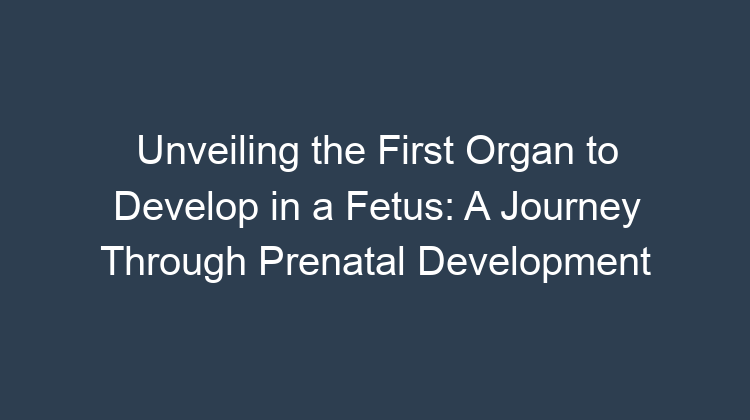From the moment of conception, the human body embarks on an extraordinary journey of growth and transformation. As a single cell divides and multiplies, it orchestrates the formation of intricate organs and systems that define our physical and cognitive abilities. Among these vital structures, one stands out as the pioneer of development: the heart.
The heart, a marvel of biological engineering, is the first functional organ to emerge in a developing fetus. It begins its remarkable journey just 18 days after fertilization, when a cluster of cells known as the primitive streak forms. Within this intricate network of cells, a specialized group emerges, destined to become the beating heart of the growing organism.
As the embryo continues its rapid development, the heart evolves from a simple tube-like structure into a fully formed organ, capable of pumping blood throughout the body. This remarkable transformation is driven by a series of intricate genetic instructions, guiding the cells to arrange themselves in specific patterns and acquire specialized functions.
The Heart’s Pioneering Role in Fetal Development
A Lifeline of Nourishment
From the moment it begins to beat, the heart assumes a pivotal role in the nourishment and survival of the developing fetus. It tirelessly pumps oxygen-rich blood throughout the body, delivering essential nutrients to every cell. Simultaneously, it removes waste products, ensuring the proper functioning of all organs and tissues.
A Symphony of Coordination
The heart’s rhythmic contractions orchestrate a symphony of physiological processes within the fetus. It ensures the proper distribution of hormones, regulates body temperature, and plays a crucial role in immune function. The heart’s harmonious functioning underpins the overall health and well-being of the developing organism.
A Bridge Between Mother and Child
The heart serves as a vital link between the mother and the developing fetus. Through the intricate network of blood vessels known as the placenta, the heart facilitates the exchange of oxygen, nutrients, and waste products between the maternal and fetal circulations.
Stages of Heart Development in the Fetus
The Primitive Heart Tube
The heart’s journey begins as a simple tube-like structure, known as the primitive heart tube. This rudimentary structure emerges just 18 days after fertilization and consists of a linear arrangement of cells capable of rhythmic contraction. The primitive heart tube is the foundation upon which the complex four-chambered heart will eventually develop.
The Looping Heart
As the embryo continues to grow, the primitive heart tube undergoes a remarkable transformation, bending and looping upon itself to form the basis of the mature heart. This intricate process involves the coordinated movement and remodeling of cells, driven by genetic instructions and mechanical forces.
The Formation of Chambers and Valves
The looping heart gradually differentiates into four distinct chambers: two atria (upper chambers) and two ventricles (lower chambers). Specialized valves develop within the heart, ensuring the proper flow of blood through its chambers and preventing backflow. The formation of these structures is essential for the efficient pumping of blood throughout the body.
Factors Influencing Heart Development in the Fetus
Genetic Determinants
The development of the heart is largely influenced by genetic factors. Specific genes provide the instructions for the formation of the heart’s chambers, valves, and specialized tissues. Mutations or abnormalities in these genes can disrupt the normal development of the heart, leading to congenital heart defects.
Environmental Factors
Environmental factors, such as maternal health, nutrition, and exposure to toxins, can also impact heart development in the fetus. Poor maternal nutrition, certain medications, and infections during pregnancy can increase the risk of congenital heart defects.
Congenital Heart Defects: A Concern for Fetal Development
Overview of Congenital Heart Defects
Congenital heart defects are structural abnormalities of the heart that occur during fetal development. These defects can range from mild to severe and can affect the heart’s ability to pump blood effectively. Some common types of congenital heart defects include septal defects, valve defects, and obstructive defects.
Causes of Congenital Heart Defects
The exact causes of congenital heart defects are often unknown, but a combination of genetic and environmental factors is thought to play a role. Some risk factors include maternal infections during pregnancy, certain medications, and genetic conditions.
Impact of Congenital Heart Defects
The impact of congenital heart defects on the fetus and newborn can vary depending on the severity of the defect. Some defects may require immediate medical intervention, while others may not cause any noticeable symptoms. Early diagnosis and treatment of congenital heart defects can significantly improve the outcome for affected individuals.
FAQ: Unraveling Common Questions about the First Organ to Develop in a Fetus
What is the first organ to develop in a fetus?
The heart is the first functional organ to develop in a fetus, beginning its remarkable journey just 18 days after fertilization.
Why is the heart the first organ to develop?
The heart’s early development is crucial for providing nourishment and oxygen to the rapidly growing fetus. It plays a vital role in the formation of other organs and systems, establishing the foundation for the overall development of the organism.
How does the heart develop in the fetus?
The heart’s development begins with the formation of the primitive heart tube, which undergoes looping and remodeling to form the four-chambered heart. Specialized valves develop within the heart, ensuring the proper flow of blood through its chambers.
What factors influence the development of the heart in the fetus?
Genetic factors, such as specific genes, play a significant role in heart development. Environmental factors, including maternal health, nutrition, and exposure to toxins, can also impact the heart’s development.
What are congenital heart defects?
Congenital heart defects are structural abnormalities of the heart that occur during fetal development. These defects can range from mild to severe and can affect the heart’s ability to pump blood effectively.







